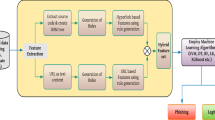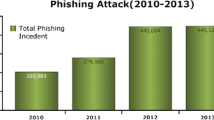Abstract
Email is an important service to exchange information for Internet users, this important use of email made it the target of various disturbances, such as spam attacks, most of the time it’s generated by advertising (Clayton 2003). Short Message Service (SMS) like emails are also the target of spam attacks, so it is necessary to make emails and messages safe from spams (Karami and Zhou 2014). This motivates the researchers to provide new solutions which can filter and detect spams based on heuristic techniques represented by the inspiration from nature (or bio-inspiration), it’s a new discipline that studies the best ideas of nature, then imitates them and applies their concepts and processes to human problems (Tahir et al. 2017, Ferreira et al. 2014), after exploring the marine world we opted for the octopods, because of its high quality of defense, and even are not very used in the world of bio-inspiration. One of the most defensive animals in their life is the octopods, they have a great ability to avoid attacks from predators, and they make an intelligent system of security that is hard to break it (Octopus-defenses 2018). In our work we proposed a technique based on the natural function of the octopod for the purpose of detect spam sms, the technique is based on two objective functions, the first is to calculate the force of move of each message, and the second is the probability of messages of each class from the learning base.





Similar content being viewed by others
References
Pierre-François Bonnefoi : Computer Security Course
Arciszewski T, Cornell J (2006) Bio-inspiration: Learning Creative Design Principia, Conference paper EG-ICE 2006: Intelligent Computing in Engineering and Architecture pp 32–53, Part of the Lecture Notes in Computer Science book series (LNCS, volume 4200)
Tahir AM, Naselli GA, Zoppi M (2017) Robotizing the Bio-inspiration, Conference paper RiTA 2017: Robot Intelligence Technology and Applications 5 pp 313–334, First Online: 31 May 2018, Part of the Advances in Intelligent Systems and Computing book series (AISC, volume 751)
Ferreira JD, Ribeiro L, Onori M, Barata J (2014) Challenges and Properties for Bio-inspiration in Manufacturing, Conference paper DoCEIS 2014: Technological Innovation for Collective Awareness Systems pp 139–148, Part of the IFIP Advances in Information and Communication Technology book series (IFIPAICT, volume 423)
Zhang Y, Wang S, Phillips P, Ji G (2014) Binary PSO with mutation operator for feature selection using decision tree applied to spam detection. Knowl-Based Syst 64: 22-31
Kumar S, Gao XY, Welch I, Mansoori M (2016) A Machine Learning Based Web Spam Filtering Approach, IEEE 30th International Conference on Advanced Information Networking and Applications (AINA), Date of Conference: 23–25 March 2016, Date Added to IEEE Xplore: 23 May 2016, Print ISSN: 1550-445X, Conference Location: Crans-Montana, Switzerland
Hidalgo JMG, Bringas GC, Sánz EP, García FC (2006) Content based SMS spam filtering, DocEng '06 proceedings of the 2006 ACM symposium on document engineering pages 107–114, Amsterdam
Cormack GV, Hidalgo JMG, Sánz EP, Zhang Y, Wang S (2007) Feature engineering for mobile (SMS) spam filtering, published in proceeding SIGIR '07 proceedings of the 30th annual international ACM SIGIR conference on research and development in information retrieval pages 871–872, Amsterdam
Xu Q, Xiang EW, Yang Q, Du J, Zhong J (2012) SMS spam detection using noncontent features. IEEE Intell Syst 27(6)
Arifin DD, Moch S, Bijaksana A (2016) Enhancing Spam Detection on Mobile Phone Short Message Service (SMS) Performance using FP-Growth and Naive Bayes Classifier, School of Computing, Telkom University, Bandung, Indonesia, The IEEE Asia Pacific Conference on Wireless and Mobile (APWiMob)
Nagwani NK, Sharaff A (2017) SMS spam filtering and thread identification using bi-level text classification and clustering techniques, Department of Computer Science and Engineering, National Institute of Technology Raipur, India. J Inf Sci 43(1):75–87
Najadat H, Abdulla N, Abooraig R, Nawasrah S (2014) Mobile SMS spam filtering based on mixing classifiers, Department of Computer Information Systems, Faculty of Computer and Information Technology, Jordan University of Science and Technology, Irbid, Jordan. Int J of Adv Comput Res 1
Joe I, Shim H (2010) An SMS Spam Filtering System Using Support Vector Machine, Conference paper FGIT 2010: Future Generation Information Technology pp 577–584, Part of the Lecture Notes in Computer Science book series (LNCS, volume 6485)
Bande Serrano JM, Palancar JH, Cumplido R (2014) The Evaluation of Ordered Features for SMS Spam Filtering, Conference paper CIARP 2014: Progress in Pattern Recognition, Image Analysis, Computer Vision, and Applications pp 383–390, Part of the Lecture Notes in Computer Science book series (LNCS, volume 8827)
Caraveo C, Valdez F, Castillo O (2018) A new optimization meta-heuristic algorithm based on self-defense mechanism of the plants with three reproduction operators. Soft Comput 22(15):4907–4920
Cervantes L, Castillo O, Hidalgo D, Martinez-Soto R (2018) Fuzzy dynamic adaptation of gap generation and mutation in genetic optimization of type 2 fuzzy controllers. Adv Oper Res 2018: 9570410, 13 pages
Castillo O, Amador-Angulo L (2018) A generalized type-2 fuzzy logic approach for dynamic parameter adaptation in bee colony optimization applied to fuzzy controller design. Inf Sci 460–461:476–496
Amador-Angulo L, Castillo O (2018) A new fuzzy bee colony optimization with dynamic adaptation of parameters using interval type-2 fuzzy logic for tuning fuzzy controllers. Soft Comput 22(2):571–594
Olivas F, Amador-Angulo L, Perez J, Caraveo C, Valdez F, Castillo O (2017) Comparative study of Type-2 fuzzy particle swarm, bee Colony and bat algorithms in optimization of fuzzy controllers, special issue Extensions to Type-1 Fuzzy Logic: Theory, Algorithms and Applications, received: 16 July 2017 / revised: 18 august 2017 / accepted: 23 august 2017 / published: 28
Amador-Angulo L, Mendoza O, Castro JR, Rodríguez-Díaz A, Melin P, Castillo O (2016) Fuzzy Sets in Dynamic Adaptation of Parameters of a Bee Colony Optimization for Controlling the Trajectory of an Autonomous Mobile Robot. Sensors (Basel) 16(9):E1458. https://doi.org/10.3390/s16091458
Wang G-G, Deb S, Zhao X, Cui Z (2018) A new monarch butterfly optimization with an improved crossover operator. Oper Res 18(3):731–755
Kout A, Labed S, Chikhi S, Bourennane EB (2018) AODVCS, a new bio-inspired routing protocol based on cuckoo search algorithm for mobile ad hoc networks. Wirel Netw 24(7):2509–2519
Hamou RM, Amine A, Boudia A (2013) A New Meta-Heuristic Based on Social Bees for Detection and Filtering of Spam, Department of Mathematics and Computer Science, Dr. Moulay Tahar University of SAÏDA, Saida, Algeria. Int J Appl Metaheuristic Comput
Hamou RM, Amine A, Boudia A (2015) A New Meta-Heuristic based on Human Renal Function for Detection and Filtering of SPAM, Department of Mathematics and Computer Science, Dr. Moulay Tahar University of SAÏDA, Saida, Algeria. Int J Inf Secur Priv 9(4)
https://www.futura-sciences.com/planete/definitions/zoologie-poulpe-9551/. Accessed 05th September 2018, at 22:41
Octopus-defenses (2018) https://www.octopusworlds.com/octopus-defenses/. Accessed 18 August 2018 at 01:26 am
http://expressdigest.com/florida-diver-tries-to-touch-giant-octopus-and-gets-inked/. Accessed 06th September 2018, at 19:47
AL HIYARI IMANE: Information on octopod 2017, https://mawdoo3.com/Information_on_octopod. Accessed 07th August 2018, at 11:37
http://zonalandeducation.com/mstm/physics/mechanics/forces/newton/mightyFEqMA/mightyFEqMA.html. Accessed 22nd August 2018, at 20:26
http://zonalandeducation.com/mstm/physics/mechanics/forces/newton/mightyFEqMA/mightyFEqMA.html. Accessed 02nd August 2018, at 11:46
Tippens PE (2007) Acceleration 2007, https://www.stcharlesprep.org/01_parents/vandermeer_s/Useful%20Links/Honors%20Physics/pdf%20lectures/Accelerat on.pdf. Accessed 22nd August 2018, at 22:46
Holzner S (2018) How to calculate acceleratimon, https://www.dummies.com/education/science/physics/how-to-calculate-acceleration/. Accessed 01st September 2018, at 10:23
UCI Machine Learning (2016) Sms spam collection, 2016, https://www.kaggle.com/uciml/sms-spam-collection-dataset/home. Accessed 05th January 2018, at 20:50
Almeida TA, Hidalgo JMG (2011) Sms spam collection V.1. 2011, http://www.dt.fee.unicamp.br/~tiago/smsspamcollection/. Accessed 05th January 2018, at 22:51
Srivastava H (2017) What is k-fold cross validation? 2017, https://magoosh.com/data-science/k-fold-cross-validation/. Accessed 08th September 2018, at 23:11
Hastie & Tibshiran (2009) K-fold cross validation, SLDM III Cross-v Alidation and bootstrap
Abdelmalek amine (2012) Text Mining Course. Department of Computer Science, Dr. Tahar Moulay University of Saida, Saida, Algeria
Cavnar WB, Trenkle JM (1991) N-Gram-Based Text Categorization, Environmental Research Institute of Michigan, P.O. Box 134001, Ann Arbor MI 48113–4001
Clayton R (2003) All about spam, Accessed 04th August 2018, at 10:51
Karami A, Zhou L (2014) Improving static SMS spam detection by using new content-based features completed research paper. Twentieth Americas Conference on Information Systems, Savannah
Author information
Authors and Affiliations
Corresponding author
Additional information
Publisher’s note
Springer Nature remains neutral with regard to jurisdictional claims in published maps and institutional affiliations.
Rights and permissions
About this article
Cite this article
Mokri, M.A.E., Hamou, R.M. & Amine, A. A new bio inspired technique based on octopods for spam filtering. Appl Intell 49, 3425–3435 (2019). https://doi.org/10.1007/s10489-019-01463-y
Published:
Issue Date:
DOI: https://doi.org/10.1007/s10489-019-01463-y




